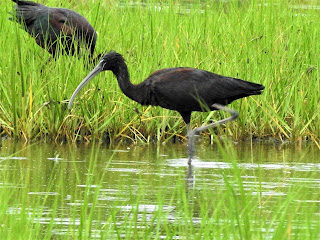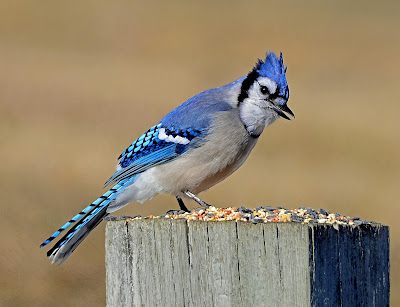Glossy Ibis
by Sue Pike
published weekly in these seacoast newspapers The York Weekly/Portsmouth Herald/Fosters Daily/Exeter Herald
Glossy ibis are a bird I never expect to see around
here-they look like they should be hanging out in the tropics, wading through
some Amazonian mudflats with their long spindly legs or swooping over a
crocodile-infested watering hole in the African savanna. They are close cousins to the more commonly
recognized great blue herons and egrets.
There is something very “New England” about a great blue heron or a
snowy egret regally perched on the edge of salt marsh. People have weather vanes on their houses and
lawn art that depict herons in this regal pose or flying overhead, necks tucked
in, still stately in flight. Ibis somehow
don’t conjure up the same image.
However, since I first saw some drop down into a New England salt marsh,
I was in love.
 |
| Glossy ibis crabbing in salt marsh panne Sue Pike photo |
Glossy ibis are tall, dark, slender, wading birds, and while
they look different enough that it would be hard to confuse them with something
like a heron or an egret I think of them as being in that category of
birds-tall birds with long necks and long legs that like to hang out in
marshes. Unlike herons (and egrets-which are basically a type of heron) which
have long, sharp chisel-like beaks, ibis have long, somewhat slender downward-curving
beaks. Herons fly with slow, ponderous
wing beats, their necks tucked in, legs trailing behind. Ibis, on the other hand, I always see flying
in chaotic flocks, more rapid wingbeats than the stately herons, dropping down
then flapping up. They fly like I think
I would if I could fly, lots of disorder and inelegance. A key difference from herons—they don’t tuck
their necks in when they fly, making them look all the more gangly and awkward.
 |
| Unlike herons and egrets, ibis forage in flocks Sue Pike photo |
Ibis bills are distinctively down-curved. They are shaped like this for a reason. Herons and egrets usually hunt by standing or
slowly walking and waiting for a fish to come close and then striking with a
rapid bill thrust. Fish constitute the majority of their diet. Ibis, on the other hand, can’t hunt like this
this—they don’t have a bill meant for striking at prey. Instead they wade around in shallow water,
swishing their bill through the mud at the bottom of whatever wetland they
happen to be in, feeling for prey. They
mostly eat insects and crustaceans—they can’t catch a lot of fish with this particular
foraging technique. In addition to
crustaceans, ibis may catch and eat some small fish, leeches, snails and frogs.
They will also hunt on dry land, and in Florida have been known to eat small
snakes. While herons are visual
predators (they watch for prey then strike), ibis are tactile predators, they
feel for prey with those slender bills.
Glossy ibis are the most widespread species of ibis-in
addition to the east coast of North America, they can be found in South
America, southern Europe, Africa, Asia, India and Australia. They are the only species of ibis you are
likely to see around here. If you can
get a good look on a sunny day you will see just how beautiful these birds
are-they aren’t just nondescript dark ibis, their iridescent plumage shines in
the sun, their plumage has a metallic glint that ranges from copper to
green. Watch for them in a marsh near
you.



Comments
Post a Comment